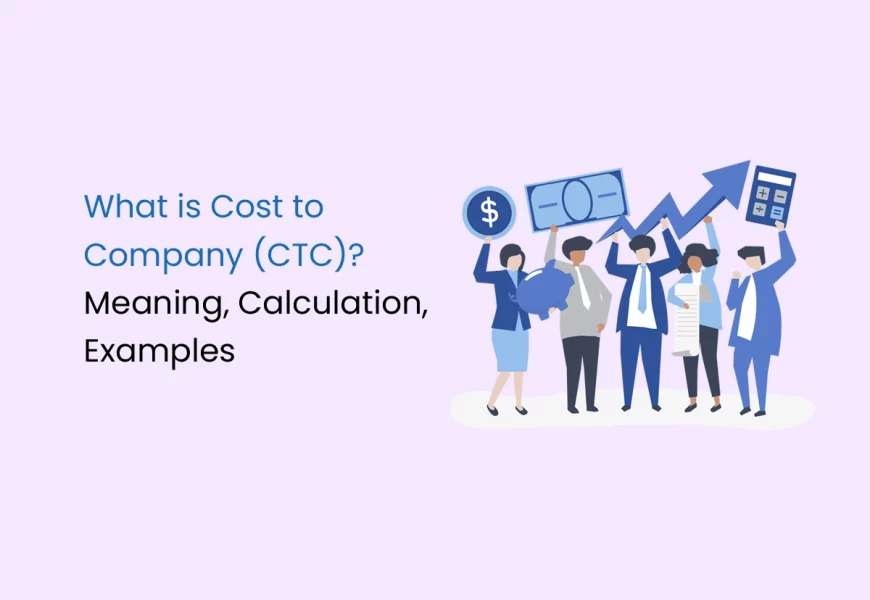Cost to Company, or CTC, can be defined as the annual expenditure incurred by a company to pay an employee. This amount combines the salary and the variable pay.
This article will talk about the multiple variants that go into the calculation of CTC and much more.
What is CTC?
CTC, or Cost to the Company, refers to the total expenses a company incurs on an employee in a year. This includes the monthly salary and other benefits provided to the employee. CTC is a term commonly used by private companies in India when offering employment.
CTC includes both monetary and non-monetary elements. The following components make up the in-hand salary, and as a result, are also included in the CTC:
- Basic Salary: The core part of the salary.
- Dearness Allowance (DA): A fixed amount to offset inflation.
- Incentives or Bonuses: Additional earnings based on performance.
- Conveyance Allowance: Money for commuting expenses.
- House Rent Allowance (HRA): Assistance for housing expenses.
- Medical Allowance: Money for medical expenses.
- Leave Travel Allowance (LTA/LTC): Assistance for travel during leave.
- Vehicle Allowance: Compensation for vehicle-related costs.
- Telephone/Mobile Phone Allowance: Money to cover communication expenses.
- Special Allowance: Any additional payment for specific reasons.
CTC gives a complete picture of an employee’s total benefits and compensation from the company.
A significant part of CTC (Cost to the Company) includes compulsory deductions, such as provident fund contributions and medical insurance. These are part of the employee’s compensation package, but they are not received as part of the in-hand salary. However, they do increase the total CTC.
CTC is made up of three components: Direct Benefits, Indirect Benefits, and Savings Contributions.
- Direct Benefits are the amounts paid monthly to the employee, forming part of the take-home (net) salary, which is subject to government taxes.
- Indirect Benefits are advantages the employee enjoys without paying for them. The company covers these costs, but they are added to the CTC since they are company expenses. Examples include insurance premiums or transport allowances.
- Savings Contributions refer to amounts set aside for future benefits, such as contributions to the Employee Provident Fund (EPF), which also adds to the total CTC.
The Basic Salary is the core part of the employee’s salary, paid before any extras like bonuses or overtime are added, and before any deductions like salary sacrifice schemes are taken off.
Tax on Basic Salary: Basic salary is always taxable, and it shouldn’t exceed 40% of the total CTC to avoid higher tax liabilities. However, setting the basic salary too low can reduce other parts of the salary package. Junior-level employees usually have a higher basic salary compared to senior-level employees. A high basic salary leads to a higher tax obligation for the employee.
How to Calculate CTC?
CTC, or Cost to the Company, is calculated using the formula:
For example, if Siya’s basic salary is ₹20,000, and the employer pays ₹4,500 for health benefits, with Siya contributing 10% of her salary to the Employee Provident Fund (EPF), then her CTC would be:
This is the total cost the company incurs on Siya.
Is CTC calculated yearly or monthly?
CTC is typically calculated every year. It represents the total annual expense a company spends on an employee, including salary, benefits, and other contributions or deductions. However, the payments to the employee, such as salary, are made monthly.
Calculating Gross and Net Salary
Before learning how to calculate the gross and net salary, let’s learn what these terms mean.
Gross Salary
Gross salary is the total salary an employee earns before any deductions. It includes various components like:
- Basic Pay: The core salary, including regular earnings, salary arrears, and overtime incentives.
- Allowances: These may include House Rent Allowance (HRA), travel allowance, medical allowance, special allowance, and more.
- Perquisites: Non-cash benefits such as fuel charges, rent for electricity, and paid sick leave.
The formula to calculate gross salary is:
Gross salary is usually subject to deductions for taxes and contributions like Provident Fund (PF), Life Insurance Corporation (LIC), Public Provident Fund (PPF), and mutual funds.
Net Salary
Net salary is the amount an employee takes home after all necessary deductions have been made from the gross salary. Some deductions, like taxes and provident fund contributions, are mandatory, while others depend on the company’s policies.
The formula to calculate net salary is:
Difference Between Net Salary, Gross Salary, and CTC
- CTC (Cost to the Company): This is the total cost a company incurs for an employee, including salary, benefits, and contributions.
- Gross Salary: The employee’s salary before deductions.
- Net Salary: The actual amount the employee takes home after all deductions.
Net salary is always lower than gross salary due to these deductions.
Example of Gross and Net Salary Calculation from CTC
Let’s consider an example where Raghav has applied to Company ABC and has been offered a salary package with the following details:
| Salary Component | Amount (Annual, INR) |
|---|---|
| CTC | 6,00,000 |
| Basic Salary | 4,00,000 |
| Travel Allowance | 50,000 |
| House Rent Allowance | 45,000 |
| Leave Travel Allowance | 60,000 |
| Provident Fund Contribution | 84,000 |
| Gratuity | 29,630 |
Gross Salary Calculation: Using the formula for gross salary, let’s calculate the salary:
Gross Salary = ₹6,00,000 – (₹84,000 + ₹29,630)
Gross Salary = ₹5,45,629
This is the salary Raghav would receive before taxes and other deductions.
Net Salary Calculation:
Now, let’s calculate the net salary by subtracting the applicable income tax. For this, under the new tax regime, salaries under ₹7 lakhs per annum are exempted from taxation.
So, Raghav’s take-home pay after tax deductions would be ₹5,45,629 annually.
FAQs about CTC
Is the Cost to Company (CTC) the same as take-home salary?
No, CTC includes the total cost the company spends on the employee, including basic salary, allowances, bonuses, and provident fund contributions. Take-home salary, or net salary, is the amount the employee receives after deductions like taxes and provident fund contributions.
How are gross salary and net salary different?
Gross salary is the total salary paid to employees before deductions like taxes, insurance, or other benefits. Net salary (or take-home pay) is the amount received after all mandatory deductions such as tax, provident fund (EPF), and insurance premiums.
What is Cost to Company (CTC) and Gross Salary?
Gross salary is the total compensation paid to the employee before deductions. CTC is the overall cost the company spends on the employee, which includes gross salary plus additional benefits and savings contributions.
How is Cost to Company (CTC) calculated?
CTC is calculated as:
CTC = Direct Benefits + Indirect Benefits + Savings Contributions
- Direct Benefits: The employee’s take-home pay or net salary.
- Indirect Benefits: Non-cash benefits paid by the company, such as insurance.
- Savings Contributions: Monetary contributions like the Employee Provident Fund (EPF).
What does Cost to Company (CTC) include?
CTC includes both monetary and non-monetary amounts such as:
- Basic Pay
- Dearness Allowance (DA)
- Incentives or Bonuses
- Conveyance Allowance
- House Rent Allowance (HRA)
- Medical Allowance
- Leave Travel Allowance (LTA)
- Vehicle Allowance
- Telephone/Mobile Allowance
- Special Allowance
What is expected Cost to Company (CTC)?
Expected CTC refers to the salary and benefits a candidate expects from the organisation when negotiating a job offer.
Is CTC the same as in-hand salary?
No, in-hand salary refers to the net amount received by the employee after deductions such as taxes and EPF. CTC includes both the in-hand salary and additional benefits, making it the total cost incurred by the company on the employee.
What is the CTC break-up?
The CTC is broken down into different components, including:
- Basic Salary: Typically 40-45% of the CTC.
- HRA (House Rent Allowance): Provided to cover accommodation costs.
- Medical Allowance: A fixed amount for medical expenses.
- EPF Contribution: A 12% contribution of basic salary and Dearness Allowance (DA), deposited into the employee's EPF account.
What are the Cost to Company (CTC) benefits in India?
There are two types of benefits:
- Direct Benefits: These are paid monthly to the employee and form part of their take-home salary.
- Indirect Benefits: Non-monetary perks like insurance or company-paid expenses, added to the employee’s CTC but not part of take-home pay.
How can you make the most of the Cost to Company (CTC) being offered?
To maximise your CTC, try to increase the direct benefits. You could:
- Opt for conveyance allowances instead of a company pick-up/drop service (tax-free).
- Request food allowances or reimbursements for meal expenses.
- Convert health coverage into medical reimbursements if your company offers ESI benefits.
- Ask for health coverage for family members.














